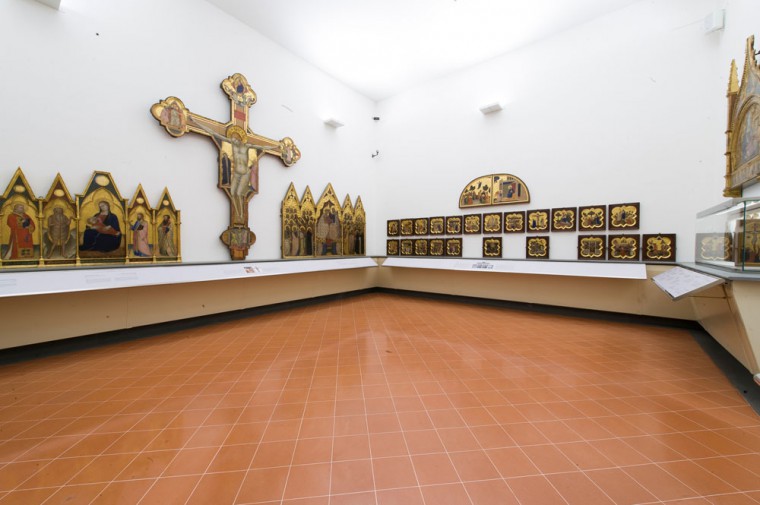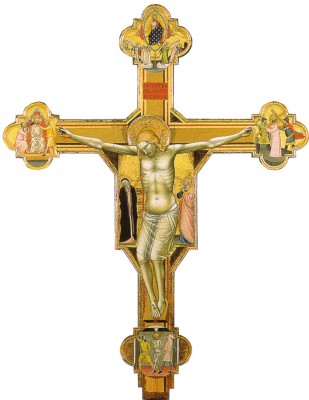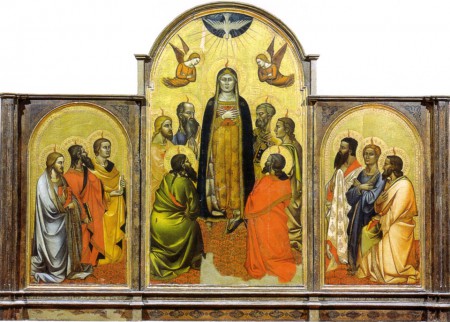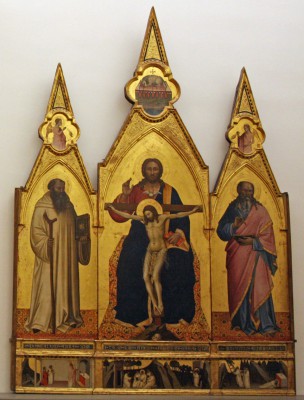Florentine Gothic

View of the “Giottesque Room”
The last section of the Gallery on the ground floor is dedicated to Florentine Gothic painting and is spread out over 3 rooms: one dedicated to 13th and early 14th century, another to Giottesque painters and the last to Orcagna and his brothers. Gold-backed altarpieces represent an invaluable art collection coming from the most important Florentine churches and ancient, suppressed convents. The brilliant colors of recent restorations introduce the visitor to the most popular subjects requested by the Church and merchants during the 14th century.
The 13th and Early 14th century Room
This first hall houses the nucleus of the most ancient artworks showcased inside the Galleria dell’Accademia. One can admire Gothic paintings, all on wood, such as a painted crucifix, which was usually hang above the main altar inside churches, gothic polyptics and a Majesty (always an Enthroned Virgin Mary and Child) which often decorated side altars, or scenes of the lives of Saints, painted for didactic and devotional purposes.
 Pacino di Bonaguida: Tree of Life (1305-10) panel painting
Pacino di Bonaguida: Tree of Life (1305-10) panel painting
The largest panel exhibited in the hall is a fascinating and very complex tree-shaped cross by Pacino di Bonaguida, symbolizing the Tree of Life. The painting was originally housed in a convent of Clarissa nuns in Florence. According to the Apocalypse, this Tree represents Salvation and offers gifts to humankind, depicted as fruits alongside the twelve branches.
The scenes in the roundels hanging from these branches represent episodes of Christ’s life, his Passion and Glory. The tree is rooted in the Garden of Eden at the very bottom, where scenes from Genesis about Creation and Adam and Eve’s life play out. The four figures seated or kneeling at the base of the cross are, from left to right, Moses, St. Francis, St. Claire, and St. John the Evangelist. Up above in the cusp the celestial court of Heaven, with Enthroned Christ and the Virgin Mary, is surrounded by red angels, saints and prophets. Between Heaven and the cross one can distinguish a pelican piercing its breast to feed its young with blood: it represents a symbol of Christ’s sacrifice on the cross for the salvation of mankind. Precious details are shown in the composition, which reveals the exceptional technical skills of Pacino di Buonaguida as a painter and very well-known illuminator.
The Giottesque Room
This room houses works by 14th century followers of Giotto. The great Florentine artist renewed Florentine painting by introducing a more natural portrayal of the surrounding environment, and was considered “the most sovereign master of painting in his time, who drew all his figures and their postures according to nature”, as chronicler Giovanni Villani defines him. In this hall, the only artwork by Giotto is a fragment of a detached fresco painting coming from the Badia Fiorentina, Florence’s oldest abbey. The fragment shows a sheperd’s head of exceptional pictorial quality, which helped date the work to around the 1320s.

Bernardo Daddi’s Crucifix
Among Giotto’s pupils was Bernardo Daddi, by whom there are various goldbacked panel paintings in the room and, above all, a large painted Crucifix, formerly exposed in the Florentine church of San Donato in Polverosa. The cross was located above the main altar and features the typical Gothic pose of a “Christus patiens”, and follows the iconography requirements Giotto had set with the crucifix he painted for the Basilica of Santa Maria Novella in Florence at the turn of hte century (ca. 1295). In Daddi’s Crucifix (ca. 1345), Christ’s heavy body is flanked by the sorrowful figures of Mary and John the Evangelist, while the ends of the arms depict “The Mocking of Christ”, “Christ at the Column” and “The Way to Calvary”. At the top of the panel, Christ is painted as “Jesus Pantocreator at the Last Judgment” within a shiny almond shaped space. In the same branch of the cross, one can read the Latin inscription “DICEST IESUS NAZARENUS REX IUDAEORUM” (Jesus of Nazareth King of the Jews).

Two of Taddeo Gaddi’s formelle – The Crucifix and Stigmata of St. Francis
In the hall one can admire also Taddeo Gaddi, one of Giotto’s closest pupils. Taddeo spent about twenty-four years within Giotto’s “bottega” or workshop, and became one of his greatest followers in Florence. The room showcases a fascinating series of trefoiled panels illustrating Scenes from the Life of Christ and St. Francis of Assisi, formerly housed in the Basilica of Santa Croce in Florence where they may have originally adorned the wooden choir stalls.
The small-format works exhibited in the Giottesque room used to be easily transportable sacred images designed for private devotion which merchants and pilgrims often carried on their long and hazardous journeys. The donor used to enthrust the protection along the journey to the Virgin Mary or Saints they were particularly devoted to, often chosen according to the name of the patron himself.
The Orcagna Room
This room takes its name from several of the works displayed, executed by the four artist brothers who were active in Florence from around 1335 up to the end of the century: Andrea di Cione, Nardo, Matteo and Jacopo di Cione. Andrea di Cione was one of the leading artists in the mid-14th century in Florence, active as painter and sculptor. He was nicknamed the “Orcagna” (arcangel) and usually worked in collaboration with his brothers at their flourishing and well-known “bottega” in Florence, run by Andrea. They were all strongly influenced by the naturalism of Giotto and achieved an outstanding level of technical skill, admired in the altarpieces displayed here, which offer a brilliant chromatic range set off by the contrast with the gold background. The Orcagna brothers and their followers used precious goldleaf for the decoration of the sumptuous fabrics and draperies covering the thrones and pavements, refined with the use of different punches.

Andrea di Cione, The Pentecost
In this room, one should particularly admire the “Pentecost” by Andrea di Cione showing the moment in which the Holy Spirit, symbolized by a white dove on the top, appears as tongues of fire and descends upon the Apostles and the Virgin Mary. The event, narrated in the Acts of Apostles (2, 1-4), was chosen as subject for the tryptic commissioned in 1365 to Orcagna for the high altar of the Church of SS. Apostoli (Apostle Saints) in Florence. The painter depicts a monumental standing Madonna that dominates the central stage of the composition, surrounded by six kneeling Apostles and two angels in flight who are witnessing the arrival of the Holy Spirit. Three Apostles are set in each of the lateral panels converging diagonally towards the centre of the triptych: in particular, one of them looks outward, involving the viewer in the sacred event. It is likely that this exceptional goldbacked altarpiece had Gothic cusps which are now lost.

Nardo di Cione, The Trinity
The second artwork to admire in the room is the large, gold-backed triptych featuring an imposing, solid God Father enthroned behind the Crucified Christ and with the white dove which symbolizes the Holy Spirit. The monumental depiction of Trinity is inserted within the central panel of a polyptic, surrounded by two Saints, St. Romuald and St. John the Baptist. The precious panel was painted in 1365 by Nardo di Cione for the chapter house of the Monastery of St. Mary of the Angels in Florence, dedicated to Saint Romuald. The saint was the founder of the Camaldolese order, which followed the Rule of Benedict. The saint is depicted in the predella, where the painter inserted scenes of his life as the Vision of St. Apollinaris and St. Romuald on the far left, St. Romuald struck by the Hermit Marino, St. Romuald tempted by the Devil and eventually St. Romuald’s Dream, on the right below. In the precious shiny cusps, Nardo di Cione introduced two angels spreading incense on the sides while the main central cusp shows the symbol of human salvation, the “Agnus Dei” (Lamb of God).
The most important and famous panel painting exposed in the hall since February 2014 is the “Coronation of the Virgin” by Jacopo di Cione, which was restored in 2011. See the dedicated page for more details.












